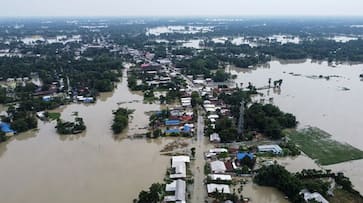Asia worst hit by climate, weather disasters in 2023, says UN; 79 calamities linked to water-related hazards
Asia was the world’s most disaster-hit region from climate and weather hazards in 2023, the United Nations said on Tuesday, with floods and storms the chief cause of casualties and economic losses.

In 2023, Asia emerged as the most disaster-stricken region globally due to climate and weather hazards, as reported by the United Nations. Floods and storms stood out as the primary contributors to both casualties and economic losses.
Last year saw unprecedented global temperatures, according to the UN's weather and climate agency, with Asia experiencing an alarming rate of warming. The World Meteorological Organization highlighted the escalating severity of heatwaves in Asia, alongside the peril of melting glaciers posing a significant threat to the region's water security in the future.
According to the WMO, Asia is experiencing a more rapid rate of warming compared to the global average. In 2023, temperatures in the region were nearly two degrees Celsius higher than the average recorded between 1961 and 1990.
“The report’s conclusions are sobering,” WMO chief Celeste Saulo said in a statement.
“Many countries in the region experienced their hottest year on record in 2023, along with a barrage of extreme conditions, from droughts and heatwaves to floods and storms," Saulo said.
The WMO chief further added, "Climate change exacerbated the frequency and severity of such events, profoundly impacting societies, economies, and, most importantly, human lives and the environment that we live in."
The "State of the Climate in Asia 2023" report underscored the accelerating pace of critical climate change indicators, including surface temperature, glacier retreat, and sea level rise. It warned that these trends would carry significant consequences for societies, economies, and ecosystems across the region.
“Asia remained the world’s most disaster-hit region from weather, climate and water-related hazards in 2023,” the WMO said.
In 2023, the annual mean near-surface temperature across Asia ranked as the second-highest on record, standing at 0.91 degrees Celsius above the 1991-2020 average and 1.87 degrees Celsius above the 1961-1990 average.
The report highlighted notably elevated temperatures stretching from western Siberia to central Asia and from eastern China to Japan, with Japan experiencing its hottest summer on record.
In terms of precipitation, the Himalayas and the Hindu Kush mountain range in Pakistan and Afghanistan saw below-normal levels. Meanwhile, southwest China grappled with a drought, witnessing below-average precipitation throughout most months of the year.
The High-Mountain Asia region, centered on the Tibetan Plateau, holds the largest volume of ice outside the polar regions. However, most of its glaciers have been retreating over recent decades, with the process accelerating. According to the WMO, 20 out of 22 monitored glaciers in the region exhibited continued mass loss in 2023.
Furthermore, the report highlighted that sea-surface temperatures in the northwest Pacific Ocean in 2023 reached their highest recorded levels.
In 2023, Asia experienced a total of 79 disasters attributed to water-related weather hazards. Of these, floods and storms accounted for over 80 percent, resulting in more than 2,000 fatalities and directly affecting nine million people.
“Floods were the leading cause of death in reported events in 2023 by a substantial margin,” the WMO said, noting the continuing high level of vulnerability of Asia to natural hazard events.
On September 7, Hong Kong witnessed a remarkable event as it recorded 158.1mm of rainfall within a single hour, marking the highest rainfall in an hour since records began in 1884. This extreme weather event was attributed to a typhoon.
The WMO emphasized the pressing need for national weather services throughout the region to enhance the provision of tailored information to officials engaged in mitigating disaster risks.
“It is imperative that our actions and strategies mirror the urgency of these times,” said Professor Saulo.
“Reducing greenhouse gas emissions and adapting to the evolving climate is not merely an option, but a fundamental necessity.”
- Asia
- High-Mountain Asia region
- Hong Kong
- State of the Climate in Asia 2023 report
- World Meteorological Organization (WMO)
- adaptation
- climate and weather-related disasters
- disaster risks
- drought
- fatalities
- floods
- glacier retreat
- global temperatures
- greenhouse gas emissions
- heatwaves
- mass loss
- melting glaciers
- national weather services
- precipitation
- rainfall
- sea level rise
- sea-surface temperatures
- storms
- surface temperature
- typhoon
- urgency
- warming
- water-related weather hazards















